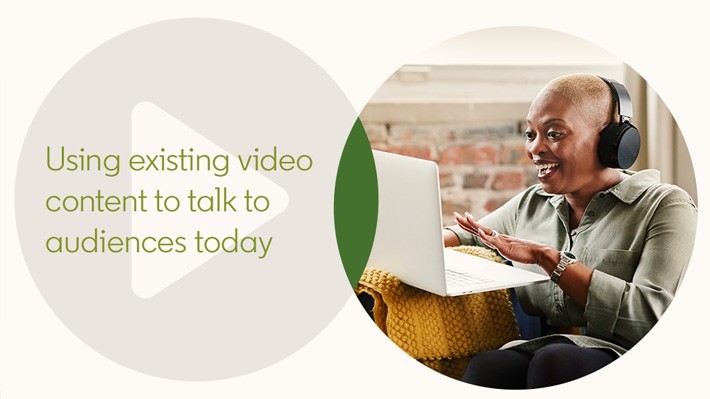Using existing video content to talk to audiences today
As B2B marketers, we know that our audiences are experiencing the world in a very different way to just a few weeks ago. Their professional life no longer involves the same routines or the same emotions. And yet, despite the huge shifts in how they do business and how they feel about the future, one thing hasn’t changed. B2B audiences, like most others, still want to hear from the brands in their lives.
When the research agency Kantar surveyed 35,000 global consumers at the end of last month, only 8% said that they thought brands should stop advertising to them during the crisis. In contrast, 78% said they wanted brands to help them in their daily lives and 75% wanted to hear from brands about how they’re responding to the situation.
The evidence suggests that B2B audiences are no different. Recent research for LinkedIn’s B2B Institute by Les Binet and Peter Field proved that emotion plays a central role in successful B2B marketing strategies – in particular emotions related to empathy, reassurance and the sense that a brand understands what you’re going through. And B2B marketers are aware of the need to play that supportive role. A total of 60% told one recent Business Marketing Club poll that they have increased communication with their customers since the crisis began.
All of which means that there are real benefits to keeping your B2B brand visible in the current situation. Peter Field recently ran additional analysis for the B2B Institute. It showed brands that maintained or grew their Share of Voice (SOV) in the global financial crisis of 2008-2009 fared better during the downturn – and grew their market share rapidly during the recovery.
Repurposing video content to balance relevance and visibility
In times of crisis, businesses are often able to grow their relative SOV just by finding a way to stay visible while others go quiet. But staying both visible and relevant feels like a challenge when most of your existing content relates to the vanished world of a few weeks ago. Updating your campaigns is doubly tricky when budgets are being cut – and your creative and production teams are split up and working from home.
Video ads are at the centre of this dilemma. We know that they’re a hugely effective way of engaging B2B audiences, earning 30% more comments per impression than non-video ads in the LinkedIn feed. However, video created any time before March is likely to show a professional life that doesn’t exist at the moment. Can sharing this content really show that we understand what our audiences and their businesses are going through?
Early evidence of how people are responding to advertising during the crisis suggests that it can. Rather than pausing video until you have time and money to create new campaigns, it’s worth exploring how you can reach out to audiences by refreshing your existing content – and using it to talk to today’s concerns.
Judge your existing brand video on tone and emotion rather than details
It’s worth bearing in mind that your existing video ads might still feel relevant to your audience – even if they contain scenes that wouldn’t happen in the current situation. This is especially true of brand campaigns, where audiences respond more to the emotion that’s expressed than to the details of what’s onscreen.
Analysis by the market research company, System1, suggests that most people don’t feel alienated by ads that are set in a time before lockdowns and social distancing. System1’s Chief Innovation Officer, Orlando Wood, argues that the crisis is bringing about a “right-brain reset”, whereby audiences are less inclined to see things in terms of black and white, right or wrong. They’re more open to nuance, more open to watching scenes from the past, and more responsive to emotional support in the form of humour and a sense of togetherness.
This suggests that you shouldn’t necessarily discard existing video content just because it shows things that couldn’t take place today, or because it strikes a light-hearted tone now and then. Scenes that feel nostalgic might actually be appreciated. Peter Field’s view on brand ads is that, “so long as the emotional platform is sympathetic to the prevailing mood, the arguments for consistency probably outweigh those for change.”
Nonetheless, there might still be value in updating your message to increase its relevance, and put more emphasis on the role your business can play in supporting customers and solving problems today. “Existing video footage will always resonate more if it shows scenes that relate to what people are going through,” says Scott Jackson of video content agency, Through The I. “A lot of brands are starting to take a more creative approach to how they edit video, so that they can adjust the story without going out and filming new footage.”
Turn product videos into human-centred stories
In the System1 research, ads that focus on people connect much more strongly with audiences at the moment than those focused on things. According to Peter Field, the campaigns that were most effective in the 2008-2009 downturn were similarly able to relate brands and products to human outcomes. They were, “emotional feelgood campaigns – albeit rooted in the reality of what the brands did for customers, rather than abstract emotional ‘wash.’”
Product detail matters in B2B – and as a result, lots of B2B marketers have lots of product footage available. “Product videos, how-to videos and short-explainer videos are three of the most popular forms of video content on LinkedIn,” says LinkedIn’s Head of EMEA Product Marketing, Jennifer Bunting. “It’s not just about demand generation and driving clicks – this type of content can drive strong engagement as well. Even today, there’s an important role for video content that can keep audiences informed about how you can help.”
Existing product video can play its engagement role more effectively if you edit it so that it includes references to your audience’s current lives and needs. That could involve creating a new introduction, a new narrative track, or editing in different types of footage that remind people of the difference you can make.
The video content platform VidMob is a Certified LinkedIn Content Partner that often works with advertisers on increasing their engagement rates for video. “We’ll often be given product shots and product video, and we’ll go out and find other footage that puts this material into more of a human story,” explains VidMob’s Senior Director for Partnerships, Steph Garofoli. “It can be as simple as editing footage of a piece of technology into a sequence with clips of entrepreneurs and small businesses, which helps people imagine how that product can make a difference for them.”
Refresh existing content with voice-over, subtitles and motion graphics
Whether your existing video content is focused on brand or products, adjusting the storyline can help to send the all-important message that you understand what your audience is going through. Fortunately, there are many ways to do this without you or your production team leaving home.
“There’s a lot of library footage out there these days and if you’re resourceful, you can use it creatively to fill in the gaps in your story,” says Scott Jackson. “We’ve already seen some great examples in this crisis of brands using a new piece of narration to give meaning and relevance to existing footage.”
As Jennifer Bunting points out, updating the narration for video content doesn’t even have to include recording a new voiceover. “Don’t forget that 79% of videos on LinkedIn are watched with the sound off,” she says. “We find that videos often generate greater engagement and clicks when they use text and visuals to tell a story. I’ve seen video ads that get great emotional resonance by spelling out the lyrics of a song through subtitles – and others generate real impact through motion graphics. And all of these things can be easily added in remotely, with people working from home.”
Animation has an obvious role to play in helping to reframe existing video content – or tell a new story in a way that doesn’t depend on filming. “It’s amazing what you can put together by animating text and logos to tell a story through movement,” says Steph Garofoli. “We’ve worked on campaigns where a client just gave us their style guide and we were able to use kinetic typography and motion design to turn that into an ad.”
Add relevance with new footage captured remotely
Sometimes though, there’s nothing that beats the human connection that comes from a person addressing the audience directly. Capturing new footage of people talking to camera enables you to update the message of a video ad in a way that’s direct, human and authentic. And there are several ways that marketers can work with video production companies to do this remotely.
“With video conferencing platforms, it’s quite straightforward to direct someone remotely while they’re filming themselves,” says Scott Jackson. “You can use different devices to shoot from a range of angles, use a clapperboard and clip-on microphones to help with the sound, and put something professional together using remote studio technology.”
Steph Garofoli says VidMob has created entire ads from footage that its clients have captured at home. “It helps if the person filming can shoot in 4K, which most smartphones now do, find a quiet environment, and look to the left of the camera when they’re speaking,” she says. “Aim to shoot against an interesting background with some depth to it as well.”
Remember – a little video storytelling can go a long way
Editing your existing video to keep it relevant to today’s situation will probably mean that you have a lot less footage to choose from. However, it’s worth remembering that video ads don’t have to be particularly long to increase your brand’s visibility and SOV. “When it comes to awareness objectives, some of the most effective video on LinkedIn involves micro-storytelling,” says Jen Bunting. “If you can edit together a relevant 15-second sequence that tells a story visually and combines with text and graphics to get your message across, you probably have all that you need.”
Video storytelling remains one of the most instantly effective ways to engage attention and emotion. And if you’ve invested in video content before the crisis, there’s every likelihood that some creative editing can help you to get real value from that content today.
Related articles



